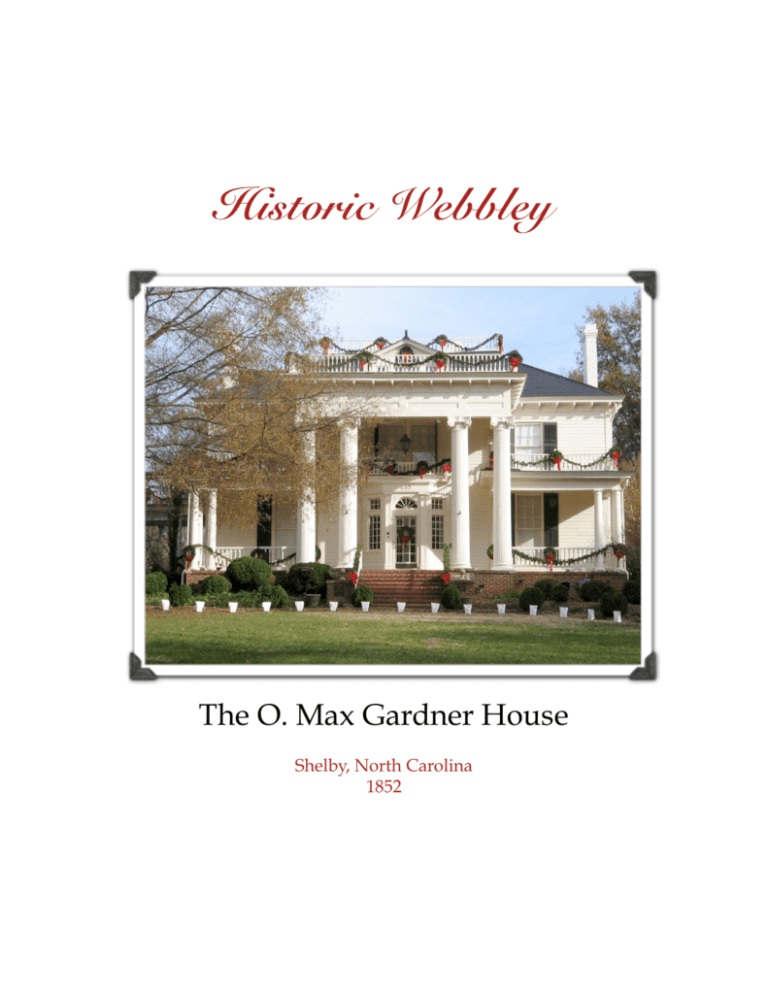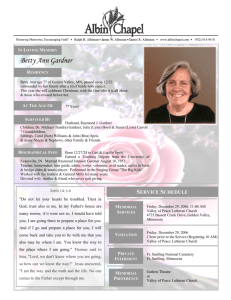Historic Webbley
advertisement

Historic Webbley The O. Max Gardner House Shelby, North Carolina 1852 Historic Webbley Webbley, the historic home located at 403 S. Washington Street in Shelby, North Carolina, is at the center of local social and political history and is one of the most architecturally distinguished buildings in the area. It is best Plaque Affixed to Webbley known today as the home of prominent former North Carolina Governor O. Max Gardner, but the property’s roots in Shelby history reach back even further. James Love donated 147 acres to form the Town of Shelby in 1841, and the town was incorporated in 1843. The two-story house that forms the core of Webbley was constructed just nine years later, on the plot labeled 19 on the original plat of Shelby. Webbley is listed on the National Register of Historic Places. Women’s Parlour The House Attorney Augustus W. Burton purchased the lot in 1850, and in 1852 built the first house on the property. The two-story Italianate house faced South Washington Street. The original house was overbuilt in 1907, but some vestiges of the original structure and design remain visible. The 1907 renovation included the addition of twin parlors at the front of the house, the three-bay front with fluted columns and two front bedrooms with adjoining baths on the second level. The side porch with the porte-cochere attached was also added at that time. The main roof is accented by gabled attic dormers centered on its west and north slopes, and the Porte Cochere 1 fluted columns support a full-height, flat-roof portico. Columns & Portico Although some of the 1852 woodwork remains, the majority of the interior is finished in the Colonial Revival manner, including molded Victorian cornices and high molded baseboards throughout the first level. Five matching brass chandeliers hang throughout the formal areas of the main level. In many areas of the house, the personal touches of Fay Webb Gardner can still be seen, including hand-painted dining room wallpaper that she selected on a trip to Europe and the lavender and yellow décor in the upper bath, which she copied from the Waldorf Astoria Hotel in New York. The Grounds Although the property was divided in 1905, the peaceful, ornate Webbley grounds remain laden with history. The tiny cottage known as The Doll House served as slave quarters before the civil war and was converted to sharecropper lodgings in the 1860s. At one time, there were approximately twenty of these small cottages on the land. The existing carriage house was constructed in 1917, in the early years of then-future Governor Gardner’s residence at Webbley, and the rose garden has been restored to its 1930s appearance. 2 Carriage House Webbley History The property, including the original house, changed hands several times between its construction in 1852 and 1905. In September of 1905, the property was subdivided into smaller lots, and the lot including the home was sold to attorney J.A. Anthony and his wife, the former Olive “Ollie” Gardner. Anthony was himself a prominent Shelby attorney, and in 1907 formed a partnership with his brother-in-law, O. Max Gardner. Governor Gardner Breaks Ground The same year, Anthony undertook the at Civil War Memorial extensive renovations that would overbuild and change the style of the entire existing home. After completing the renovations, Anthony sold the house to Judge James L. Webb. Several members of Judge Webb’s extended family moved into the house, including his daughter, Fay Webb Gardner, Fay's husband, O. Max Gardner and the couple's children. Judge Webb’s father, the Reverend George Milton Webb, also lived with the family from 1911 to 1917. Reverend Webb was a noted Baptist minister who served more than 40 churches during his ministry; his father, James Milton Webb, was the first pastor of Shelby’s historic First Baptist Church. In addition to his 20 years on the Superior Court bench, Judge Webb served as District Attorney for 12 years. Upon his death in 1930, the house passed to Fay Webb Gardner and her sister, Madge. The sisters lived in the house until their deaths, Madge in 1953 and Fay in 1969. Fay Webb Gardner Bedroom 3 On Fay’s death, her son Ralph Webb Gardner received a life estate in the property, with the remainder to a real estate holding company Fay had formed during her lifetime. Although the holding company was formed to allow easier management of her real estate holdings, it caused O. Max Gardner Bedroom unexpected complications. By the time of Ralph’s death in 1982, corporate stock was so widely dispersed that it was difficult to reach a consensus. Immediately after Ralph’s death, O. Max Gardner III, grandson of Governor O. Max Gardner, set out to purchase the property and keep it in the family. Gardner’s father, O. Max Gardner, Jr., had been born in the house in 1922 and Gardner himself had lived there with his parents in the early 1950s. Because of the complications with the corporation, it took seven years to complete the purchase. On July 7, 1989, Gardner purchased the home and three adjacent vacant lots. Soon thereafter, he and his wife, Victoria Harwell-Gardner, reopened the historic building as a bed and breakfast known as The Inn at Webbley. Politics Webbley is commonly known today as “O. Max Gardner House”, since prominent North Carolina Governor Oliver Max Gardner called it home from 1911 until 1947. Although Gardner spent time in both the Governor's mansion and in Washington, D.C., he always considered Webbley home. His widow, Fay Webb Gardner, returned to Webbley after his death and lived the remainder of her life in the house. In addition to serving as North Carolina Governor from 1929 to 1933, Gardner served as a state senator (1912-1916), Lieutenant Governor (1916-1920), Chairman of the Board of War Mobilization (1943-1945) and 4 Undersecretary of the U.S. Treasury (1946-1947). He was appointed U.S. Ambassador to England in 1947, but passed away before assuming the post. Gardner, along with his father-in-law Judge James L. Webb, E.Y. Webb and Clyde R. Hoey, Governors O. Max Gardner & Clyde R. Hoey formed the core of the group of powerful men who became known as the “Shelby Dynasty”. Their influence during difficult and changing times, including the Depression era, helped to shape state and national policies that still have an impact today. Judge Webb’s younger brother, E.Y. Webb, began his political career in the North Carolina General Assembly and then served as U.S. Congressman from North Carolina’s Ninth District for 26 years. He served as Chairman of the Judiciary Committee, introduced the bill to charter the Boy Scouts of America, and promoted food and drug regulation. In 1919, he was appointed to the federal bench by President Woodrow Wilson, and served in that capacity for an additional 28 years. Webb’s home at 331 South Washington Street was then adjacent to the Webbley property. Judge E.Y. Webb Clyde R. Hoey succeeded E.Y. Webb as 5 Congressman for the Ninth District, then followed in the footsteps of Governor Gardner, serving one term as North Carolina Governor before winning election to the U.S. Senate, where he served from 1945 to 1954. Fay Webb Gardner, Governor Gardner’s wife and the daughter of Judge James L. Webb, was herself a noted figure in Democratic national politics, and her support was instrumental in the growth of Gardner-Webb University in nearby Boiling Springs. In addition to its distinguished residents, Webbley was visited by a number of prominent politicians over the years, including: every Governor of North Carolina from 1900 to 2000; Presidents Franklin D. Roosevelt and Harry S. Truman; numerous members of the United States Senate, the United States House of Representatives and members of numerous Presidential Administrations. O. Max Gardner III, who purchased the property in 1989 following the death of his uncle Ralph Webb Gardner, is himself a noted political figure. Although he has devoted his career primarily to the practice of consumer law, he clerked for William H. Bobbitt, late Chief Justice of the North Carolina Supreme Court, served as treasurer for J. McNeil Smith’s 1978 U.S. Senate campaign and served as General Counsel to North Carolina’s Democratic Party from 1986 to 1992. During the same time period, Gardner built a groundbreaking law practice in which he O. Max Gardner III represented the 650 employees of Shelby Yarn in the first-ever successful attempt by employees to force an insolvent company into bankruptcy and developed a system for using the 6 bankruptcy courts to fight predatory lending that has garnered him national news coverage and made him a legend among consumer lawyers across the country. Arts and Literature Webbley’s long and distinguished history as home base to some of Shelby’s and the state’s most influential politicians isn’t the home’s only claim to fame. Webbley served as the inspiration for Shelby native Thomas Dixon’s 1905 novel, The Clansman. Ten years later, the home served as a real-life model for D.W. Griffith’s classic film, The Birth of a Nation, based on the novel. In later years, when O. Max Gardner III and his wife were operating the Inn at Webbley, guests included Whitney Houston, Dionne Warwick, Cissy Houston, Joe Paterno, Kevin Costner and numerous local and regional celebrities. 7







